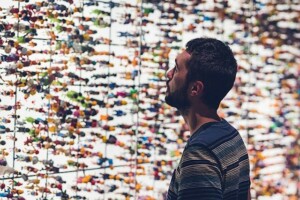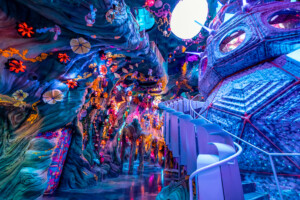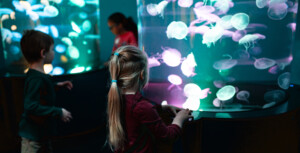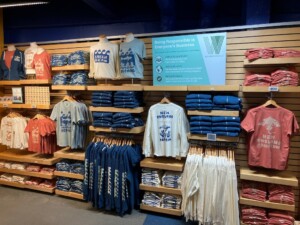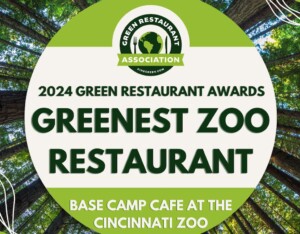“I think anybody working in a public aquarium should be in the business of talking conservation.”
The words of Dr. Peter Ross, founding Director of the Ocean Pollution Research Programme at Vancouver Aquarium’s newly-launched Coastal Ocean Research Institute.
 A keynote speaker at the ninth International Aquarium Congress (IAC) in September, Ross is an international expert on ocean pollution.
A keynote speaker at the ninth International Aquarium Congress (IAC) in September, Ross is an international expert on ocean pollution.
Ross (left – credit: Neil Fisher) spoke to Blooloop about his work as a marine toxicologist and how marine mammals are telling us the story of our seas.
“I don’t think it’s any secret that the oceans are in crisis, ” he says.
Ross calls marine mammals his “ambassadors into the ocean, ” using them to “provide me with insights into issues pertaining to ocean pollution in particular”.
What Marine Mammals Reveal About Ocean Pollutants
Employing the best available techniques and least invasive technologies, he almost always works with live animals which are either temporarily captured or biopsied from a distance, as with killer whales.
.jpg) “As a toxicologist, I look to marine mammals as wonderful canaries that can shed light on some of the priority pollutants that we find in our oceans.”
“As a toxicologist, I look to marine mammals as wonderful canaries that can shed light on some of the priority pollutants that we find in our oceans.”
Because different marine mammals all have their own particular feeding behaviours, life histories and reproductive strategies, they will be exposed to different types of pollutants in different ways.
“So, marine mammals that occupy very high positions in the food chain, like the marine mammal-eating Biggs killer whales, they have very high levels of persistent organic pollutants, ” explains Ross.

(Above: Tanu the sea otter eats an urchin – credit: John Healey)
“If I look at sea otters, that are fairly low on the food chain, but have a very high metabolism and eat very large quantities of invertebrates, they tend not to be exposed to very high levels of persistent organic pollutants, but are at risk to taking in oil and petroleum hydrocarbons that are found in near-shore environments as a result of oil spills and combustion and leaks.”
“So, different marine mammals can tell me different stories about different pollution priorities.”
“There are a number of studied designs that we’ve used which allow us to use marine mammals to provide an integrated snapshot of what’s going on in their food web or habitat, but also ways to track things back to a source and assess the effectiveness of regulations, and trends, that we’ve used, to great effect.

“For example, harbour seals demonstrate how PCBs (polychlorinated biphenyls) and DDT (dichlorodiphenyltrichloroethane) are responding to the regulations put into place since the 1970s.
“But, research with harbour seals throughout the 1980s, 1990s, until about 2005, also showed that the flame retardant PBDEs (polybrominated diphenyl ethers) were doubling every three years, and we made a very strong scientific case to highlight this concern.”
In 2004, these findings prompted Canada to phase out PBDEs and the United States to work with industry to encourage a voluntary withdrawal of the majority of PBDE products from the marketplace.
“We’ve since seen a reduction, a very quick response to those actions, in our harbour seals.”
.jpg)
Partners in Conservation
Ross describes marine mammals as sentinels:
“They’re providing an overview of what’s going on; they can be incredibly vulnerable to pollution, so it’s not only a question of providing me with scientific insight, it’s also providing a conservation story.
“If we want to protect different marine mammals at risk for future generations, we have to figure out what threatens them and, in my case, which pollutants threaten them.
“And, then, can we turn off the tap, can we implement best practices, can we devise regulations or source control?”

(Above: Microplastics pollution – credit: Chesapeake Bay Programme/Flickr Creative Commons)
“We want to minimise our impacts, or reduce it altogether, on the environment we’re studying.
“We don’t want to disturb the marine mammals, we don’t want to harm them, we don’t want to sacrifice them: they are our partners in this conversation.”
Ocean Pollution Research Programme
Ross was a federal government scientist in Canada for fifteen years until 2012, at which point there was a realignment of priorities and his programme was cut, which created an opportunity for Vancouver Aquarium.
Once in post, Ross worked to create a new ocean pollution research programme that would be science-based and conservation-oriented. It would be of interest not only to the scientific community but also to the general public, to private sector stakeholders and to government agencies.
.jpg)
(Above: Dr Peter Ross – credit: Tanya Brown)
“Essentially, we would try to walk that non-partisan, middle-of-the-road half where science and (the) right kind of science can provide a very powerful and persuasive and rational backdrop for any kind of decisions that might be made by others.
“In other words, we weren’t going to devise solutions, we were not going to implement regulations, we were not going to clean up the environment; we would provide the science that would provide guidance to others that were in the position to take steps and that could include regulations at the national level.
“It could include changes to waste water management practices; it could include changes to private sector industrial discharges and industrial design: you name it.”
Ross has been at Vancouver Aquarium for two and a half years. He and his team have set up a laboratory to look at key ocean pollution research issues, working in close partnership with government agencies and a number of academic colleagues.
Working With the Private Sector
“We also work with some private sector laboratories that are in a better position than we are to do some of the analyses that we’re doing.
“So we’re not running this independently. We have our independent strengths – and then we look to others for their strengths. We don’t try to recreate or redo what others can do better than us: we see great value in leveraging the partnerships across different groups, but we’re certainly championing the cause of ocean pollution writ large, and I think we’re working reasonably successfully to initiate a series of priority efforts right now.”

It will take the concerted efforts of all governments, working together, to address the crisis facing the world’s oceans.
“It’s an interesting one, ” observes Ross. “I’m deeply concerned about where we are today, and I’m troubled by the collective inability of humans to act together in ways that are going to sustain the oceans for future generations.
“That doesn’t mean I’m a portrayer of doom, necessarily. I actually believe, very strongly, that the power of science and knowledge provide much-needed guidance on what we can do to turn off the tap for harmful pollutants, or to mediate or mitigate in different ways.”

Science Facilitates Solutions
He is keen to point out that there is some good news.
“People think we’re just polluting more and more, but in fact, while we are polluting more and more, we’ve also learned from some of our past mistakes, and have also been able to turn off the tap on a number of very nasty chemicals. And, that’s been good news for the ocean.
“So, I’m optimistic in the sense that I have faith in our ability to use scientific tools that are reasonable and rational, and use these to provide guidance and to establish priorities.
“It’s also, I think, a remarkable time for industry. Certainly in Canada we see that industry is only enabled to fulfil its aspirations when it earns a licence for projects and activities. This means we’re seeing increased appetite on the part of the private sector to understand some of these things because they realise they’re not going to earn the respect of the marketplace, or they’re not going to earn the ability to carry out large projects unless they are seen to be doing the right thing.
.jpg)
“That means understanding the upside and downside consequences of their operations in or around the ocean.”
“So, I think there are grounds for optimism. I think anyone may remain concerned about where we are and where we’re going, but what I would say is this: that science can provide a tremendous insight into what’s going on in the ocean and the threats that ocean life faces as a result of human activities.
“And that science, that knowledge, that insight, is in a position to empower or enable or facilitate solutions.
“The solutions conversation is a wider societal conversation, though, and I would simply argue that we need to have everybody in the room acknowledging individual responsibilities as well as collective responsibilities, with industry, governments, the non-profit sector and the academic sector, as we try to use ocean science to inform those solutions at the end of the day.”
.png)
Internation Aquarium Congress
Dr. Ross’s keynote speech at the ninth IAC at the Vancouver Marine Science Centre in September will focus on Ocean Pollution and Ocean Plastics.
“Very simply put, the priorities as I see it right now for us are as follows (in no numerical order of significance):
1: Marine mammals as canaries that can provide us with the integrated view of the state of ocean food webs, and particularly as pertains to pollution;
2: Microplastics in the ocean, or plastics in the ocean: we have a very strong interest in microplastics, which are pieces of plastic smaller than 5 mm;
3: Safe, traditional sea-foods for aboriginal communities. In Canada we have aboriginal communities on our three coastlines, from the Inuit in the far north to the First Nations on the Pacific coast and the Atlantic coast and these coastal communities have long relied on an abundance of sea-foods.”
![]()
Pollution Tracker
“Our work and the work of others indicates that aboriginal communities are consuming from six to twenty-five times as much sea-food as the average Canadian, and this means the quality of, and access to, seafood or seafood in general is far more important to those communities.
“We have a project called Pollution Tracker, which is a fairly rigid monitoring programme for our coastal environment here in British Columbia, with 29 thousand kilometres of coastline.
We’ve established 40 stations up and down the coast to sample sediment and to sample mussels on the adjacent shoreline. And, these two matrices – sediments from about 10 metres below the surface of the ocean, in 10 metre deep water, and mussels provide us with a really good idea of pollution issues in that location.”
Microplastics – An Ominous Conservation Threat
Microplastics is a hot topic and one of the flagship projects Ross and his team is engaged with.
“There’s a distinct need for more scientific information on source, transport, fate and effects of microplastics in the world’s oceans.
“There are currently three people in the Vancouver Aquarium lab working on microplastics, looking at source, transport and fate as well as effects.”

“I feel that this may be a very significant conservation issue in the ocean. We don’t have a lot of evidence yet that microplastics are a significant conservation issue, but we have a lot of lab-based studies that show that the consumption of little bits of plastic by zooplankton or small fish can lead to adverse effects, and we published an account last year in a journal showing that in the North Eastern Pacific about one in every twenty or thirty individual zooplanktons has consumed plastic.
“So, these are the bottom of the food chain – they are mistaking plastic for food, a mixture of fragments and fibres.
“This, to me, is a very ominous sign that even the non-charismatic creatures that we have not typically been concerned about from a plastic pollution perspective, are ingesting plastic and may be impacted quite substantially.
“And, when we start impacting the bottom of the food chain, there are cascading implications for the rest of the chain above.”
![]()
Ross’s research involves the scrutiny of waste water treatment facilities, as some of the plastics that are found in coastal waters in British Columbia are tiny, microscopic colourful fibres.
“Some work from the UK, Australia and Scandinavia indicates that these may be coming from domestic waste water and/or textiles, and our own results here in coastal British Columbia would suggest that we find a very high concentrations of fibres near industrial zones or urban centres, and then decline as we head out to sea and more remote areas, so we’re interested in really shedding light on where these articles are coming from.
“At the end of the day, if our concerns remain that microplastics remain a conservation threat then we have to be able to work with partners to be able to identify sources, at which point society at large can work to reduce those sources and hence turn off the tap.”

Visitor Engagement: Delivering the Conservation Message
It is hoped that having heard the keynote speeches at Vancouver Aquarium in September, the conference delegates will leave the ninth IAC informed about the state of the oceans, and therefore better able to pass accurate information on to the people who visit their aquaria.
“I think anybody working in a public aquarium should be in the business of talking conservation, ” says Ross. “I feel very strongly that they must serve as a window on what’s happening in the ocean. Otherwise, I see limited value for aquaria.
“One of the tools by which we can help in that regard is by providing very strong scientific research that connects what the paying public is seeing and learning at a public aquarium with the latest findings from our research.
“Viewed that way, one can regard these people who are coming to public aquaria as citizens of the ocean, and in a position to leave that facility having learned more, having been energised, and being in a position to effect real change.
“This could mean change just in personal consumer preferences when shopping; it could mean a refreshed and re-energised look at recycling, or reuse of things that might otherwise become garbage; it could be the way in which they vote or raise issues with politicians.”
.jpg)
Aquariums Moving Forward: Opportunities and Responsibilities
“So, I think the opportunities for public aquaria are great, and the responsibility is even greater, ” says Ross.
“Aquaria have to be willing to engage in these very serious and profoundly significant conversations with the public.
“It’s up to society at large to respond to the information that we in the scientific community generate.”
Ross’s message is clear. Marine creatures may be telling us the story of our oceans, but it is up to us to give that story a happy ending.
All uncredited images kind courtesy Vancouver Aquarium









